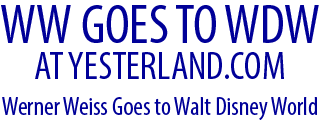
|
The Fastest Ride at Walt Disney World Cancelled... Or Maybe Not? |
||
|
|
|||
|
It was full speed ahead for the project to build a high-speed rail line between Tampa and Orlando, complete with a station at Walt Disney World. That changed this week. On Wednesday, Florida Gov. Rick Scott announced his state doesn’t want $2.39 billion from the Federal Government toward the $2.6 billion cost of high-speed rail between Tampa and Orlando. According to Scott, “The truth is that this project would be far too costly to taxpayers and I believe the risk far outweighs the benefits.” Many Florida government leaders from both parties disagreed with Gov. Scott. After all, the project would bring much-needed jobs and transportation improvements to Florida. There was also a question of the governor’s authority. State Senator J.D. Alexander (R-Lake Wales) explained, “The Constitution doesn’t allow the governor to not spend appropriations funds.” Between now and next Wednesday, rail supporters will try to figure out an alternate arrangement, perhaps trumping the governor with a veto-proof state senate majority or funneling the grant into a local planning agency, transit authority, or Amtrak. Meanwhile, other states are eager to proceed with their own high-speed rail—using the unwanted funds. According to California Gov. Jerry Brown, “The $2 billion that Florida rejected are more than welcome here.” California has plans for a $43 billion bullet-train system. But what is (or what was) Florida High Speed Rail? That’s the subject of this article.
|
|||
|
|
|||
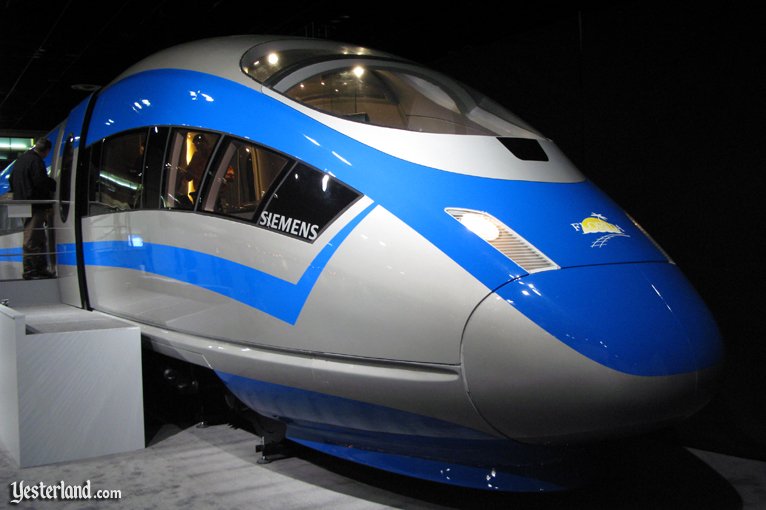
Velaro high-speed train from Siemens |
|||
|
Space Mountain reaches speeds of 28 m.p.h.; Big Thunder Mountain Railroad can exceed 30 m.p.h.; Expedition Everest hits 50 m.p.h.; Rock ’n’ Roller Coaster Starring Aerosmith accelerates from 0 to 60 in just 2.8 seconds; Test Track can send the speedometer to 65 m.p.h.; and Orlando drivers go faster than that on Interstate-4, but only when the traffic hasn’t slowed down to a crawl. What if you could board a ride at Walt Disney World that routinely travels at 168 m.p.h. and is capable of going faster than 200 m.p.h.? What if you could whiz past the cars stuck in traffic on Interstate-4—or even whiz past them if they’re going as fast as they can? It’s not a thrill ride. It’s a plan for high-speed rail service on dedicated tracks between Tampa and Orlando—with service to Walt Disney World. |
|||
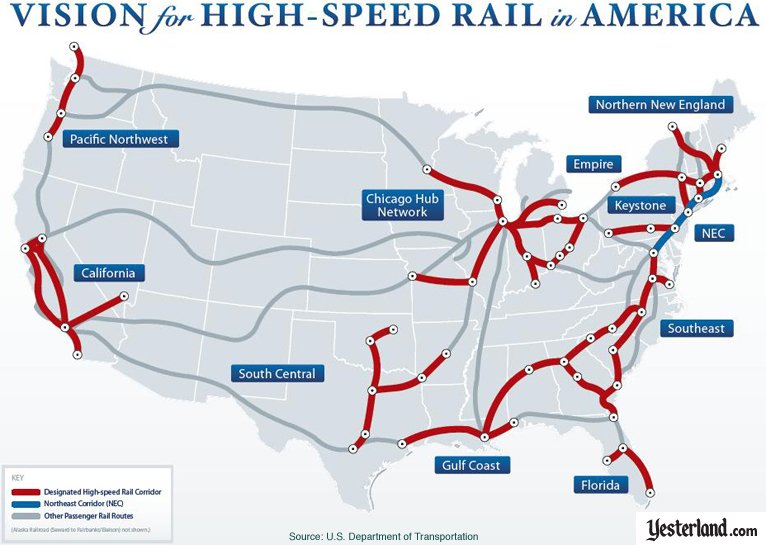
National High-Speed Rail Plan |
|||
|
On April 16, 2009, less than three months after his inauguration, President Obama declared his support for a national high-speed rail system, beginning with America’s most populated corridors. “A major new high-speed rail line will generate many thousands of construction jobs over several years, as well as permanent jobs for rail employees and increased economic activity in the destinations these trains serve,” Obama stated. “High-speed rail is long-overdue, and this plan lets American travelers know that they are not doomed to a future of long lines at the airports or jammed cars on the highways.” |
|||
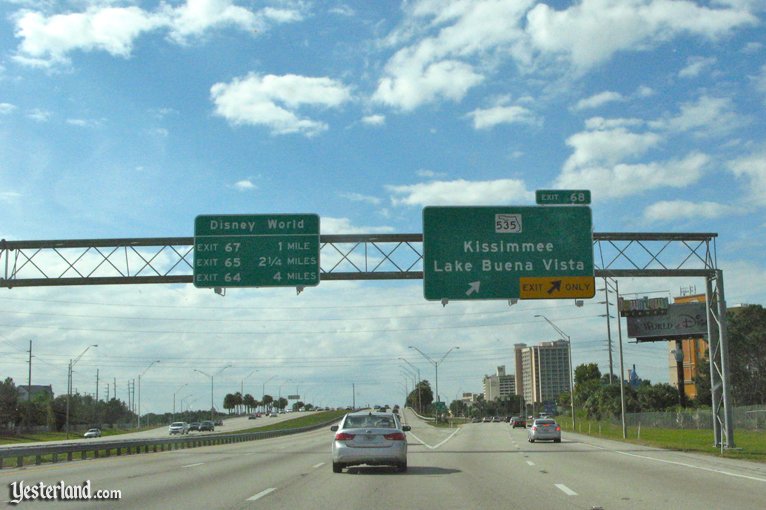
Interstate-4 approaching Walt Disney World exits |
|||
|
When the Federal Government looked for states to receive the initial grants, Florida was ready with a real plan—not just a pretty PowerPoint presentation. That’s because Florida’s voters approved an amendment to the state constitution in November of 2000, mandating the construction of a high-speed transportation network in Florida. The new Florida High Speed Rail Authority proceeded with studies, engineering designs, and even environmental impact statements. The initial route would go from Tampa to Orlando, primarily down the center of Interstate-4. It wasn’t all smooth sailing. By 2002 there was an impasse. The Authority knew that a stop at Walt Disney World would be vital to attracting enough passengers. Another stop would be at International Drive, serving the Orange County Convention Center and the many hotels in that area. However, The Walt Disney Company insisted that if the line included Walt Disney World, it would have to go nonstop to Orlando International Airport. The issue was never resolved. In November 2004, Florida’s voters removed the mandate from the state constitution. High-speed rail in Florida appeared to be dead. |
|||
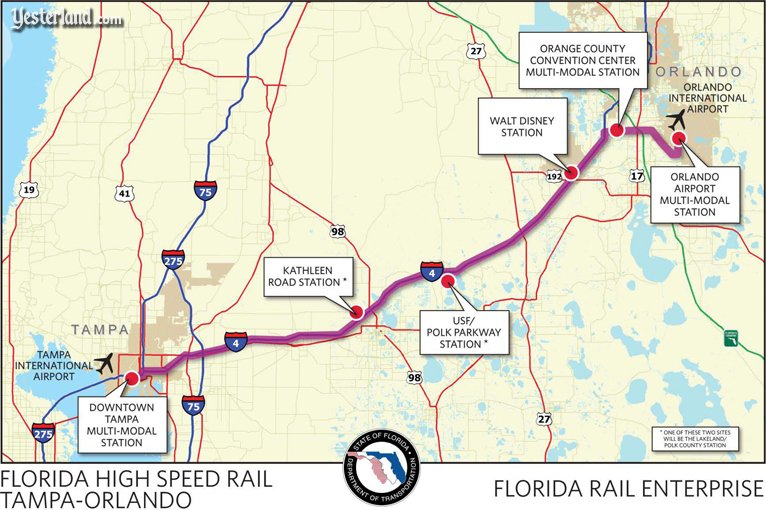
2010 Tampa-Orlando rail alignment, primarily along Interstate-4 |
|||
|
Fast forward to April 2009 when President Obama announced his high-speed rail initiative. Florida freshened up the plans from earlier in the decade and reevaluated the environmental impact statements (instead of having to start from scratch). Because the route relied on the Interstate-4 right-of-way, land acquisition was not a serious issue. Florida had the most “shovel ready” plan for the Federal Government. The first phase would be an 84-mile line connecting Tampa to Orlando, with a completion target of 2014. Eventually, the system would reach Miami, with trains on that segment traveling 220 m.p.h. And, this time, the plan included a station at Walt Disney World and the Orange County Convention Center, with Disney’s blessing. Disney even offered to donate 50 acres of undeveloped property near U.S. Hwy. 192 for a station. On January 28, 2010, President Obama and Vice President Biden appeared in Tampa, Florida, to announce $8 billion in high-speed rail grants, including an initial $1.25 billion grant for the Tampa-Orlando line, with more funds expected to follow. |
|||
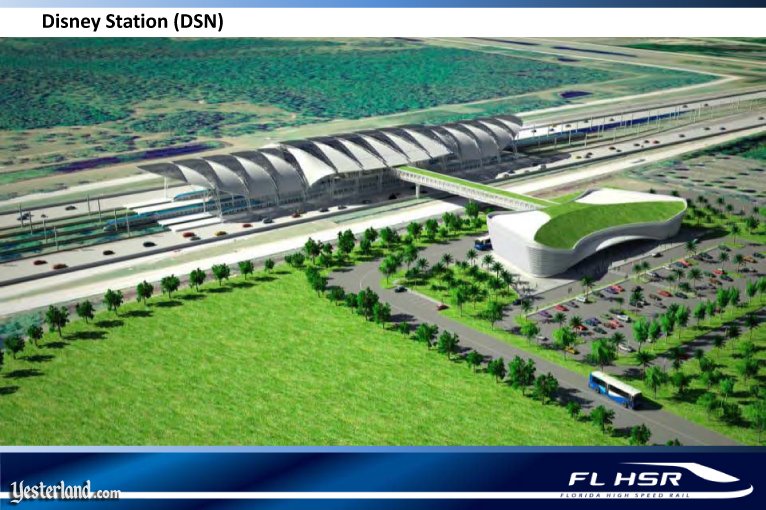
Proposed Florida High Speed Rail station at Walt Disney World |
|||
|
The exact location of the proposed Walt Disney World station was difficult to determine. According to the Final Environmental Impact Statement Reevaluation, dated May 2010, “The proposed Disney Station would be located north of U.S. 192. The station platform would be located in the median and the station facility would be located west of I-4 between U.S. 192 and the Osceola Parkway.” |
|||
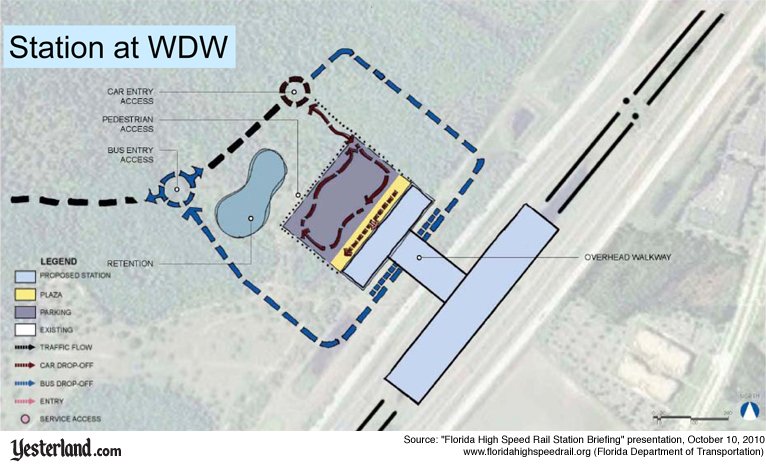
Diagram showing station south U.S. Hwy 192, with platform in the center of Interstate-4 |
|||
|
However, a publicly released PowerPoint presentation, dated October 2010, showed the station directly across Interstate-4 from the Celebration Office Center in Celebration, Florida. That would put the station south of Irlo Bronson Hwy. (U.S. Hwy 192) and north of where World Drive meets Interstate-4. |
|||
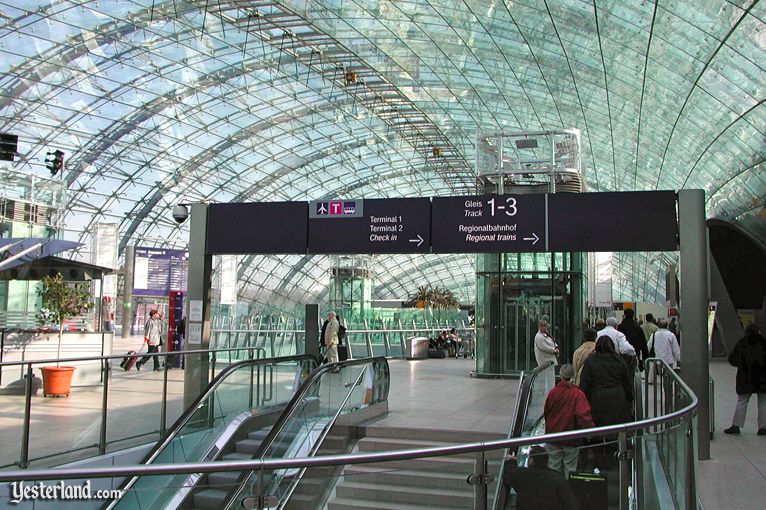
Railroad station at Frankfurt International Airport in Germany |
|||
|
At first glance, the route between Tampa and Orlando looks a bit odd. At the Tampa end, the station is downtown, but at the Orlando end, the station is at the airport. Tampa International Airport and downtown Orlando are both excluded from the system. However, the stations are multi-modal. That means that they will also be served by other types of transportation, providing numerous means for passengers to reach their destination. It’s a model that works well in Europe. At Frankfurt International Airport in Germany, a high-speed train platform and a local commuter train station are adjacent to the airport terminal. It’s surprising, however, that Orlando’s proposed SunRail commuter train line was designed without a direct connection to the proposed high-speed rail line. |
|||
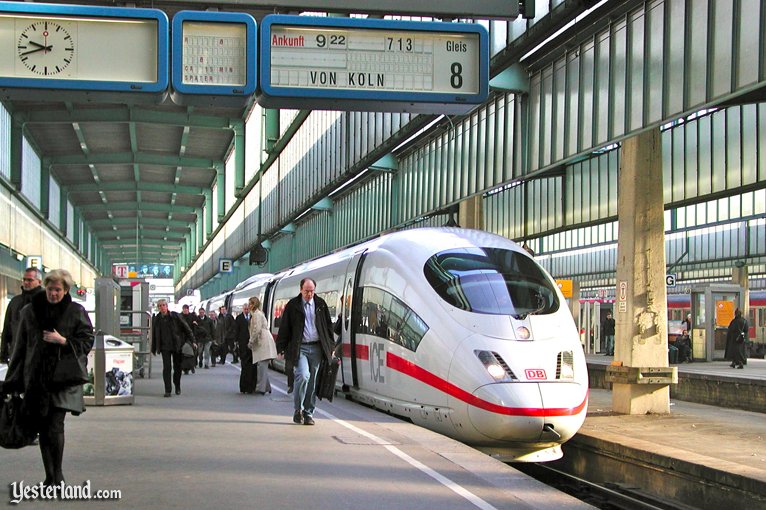
ICE (Intercity-Express) train in Stuttgart, Germany |
|||
|
In France, the TGV (Train à Grande Vitesse) system began in 1981. A TGV train set a speed record of 356 m.p.h. You might also remember the TGV train in the Timekeeper attraction at Magic Kingdom park. Germany launched its ICE (InterCity-Express) service in 1992 Spain opened its AVE (Alta Velocidad Española) system in 1992. Plans call for 3,400 miles of high-speed rail in Spain. Japan pioneered high-speed rail in 1964 with its famous bullet trains. South Korea and China are building high-speed systems. There’s already high-speed rail in the United States too. Amtrak’s Acela Express began service between Boston and Washington in 2000, with speeds up to 150 m.p.h. |
|||
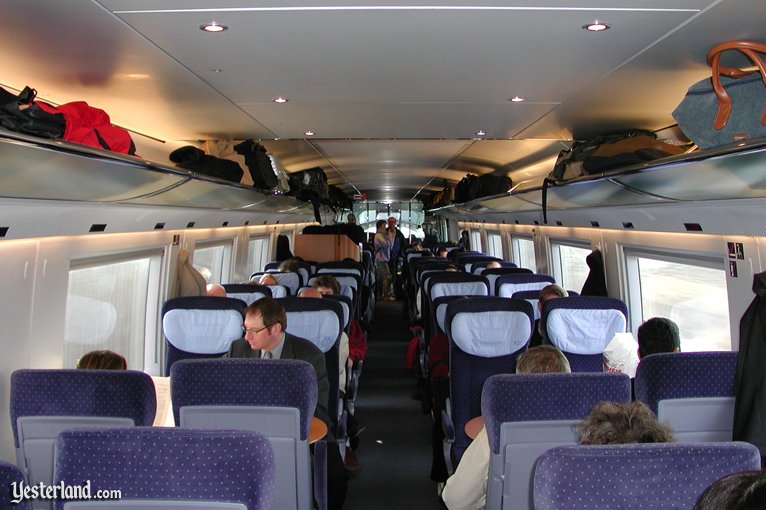
2nd class seating on an ICE train from Stuttgart to Frankfurt |
|||
|
The plans in Florida called for bidders to design, build, operate, maintain, and possibly finance the high-speed rail project. Each bidder would be a consortium of companies that could provide everything. One such consortium is Florida Rail Ventures, a consortium of Germany’s Siemens and other companies from France, Spain, Sweden, and the United States. Back in October and November of 2010, Florida Rail Ventures took an exhibit to several Florida locations. The rest of this article consists of photos from “The Future of Florida High-Speed Rail Tour” when it was at the Orange County (Florida) Convention Center. |
|||
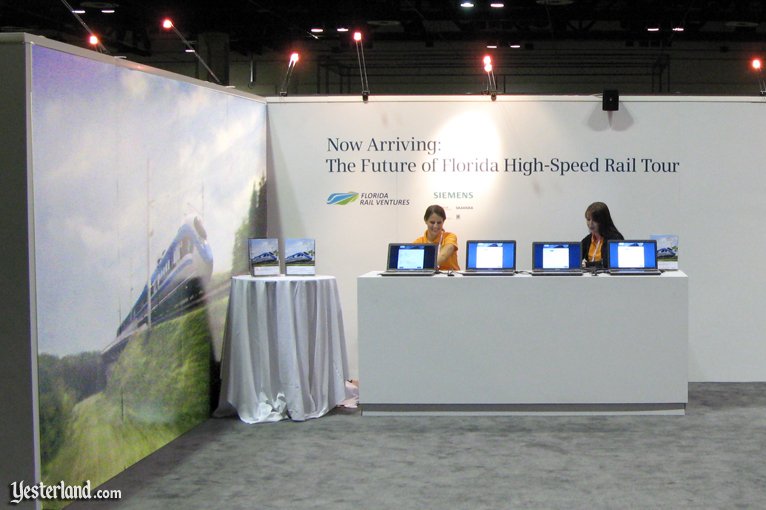
Entrance to “The Future of Florida High-Speed Rail Tour” display |
|||
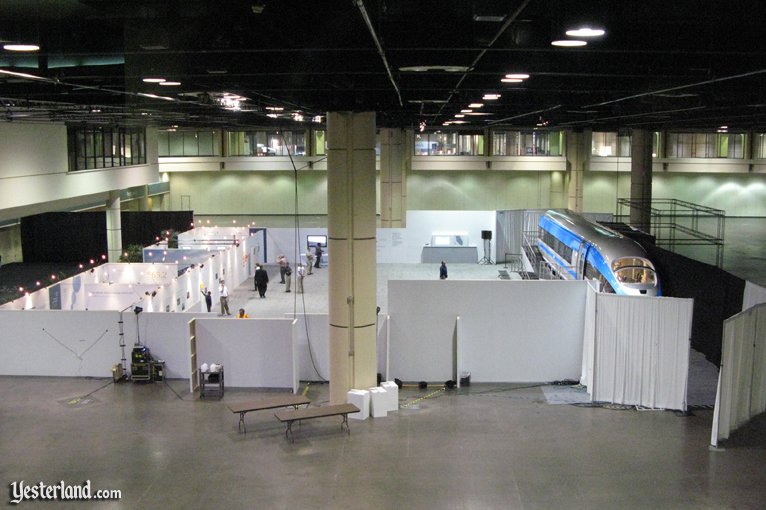
“The Future of Florida High-Speed Rail Tour” overview |
|||
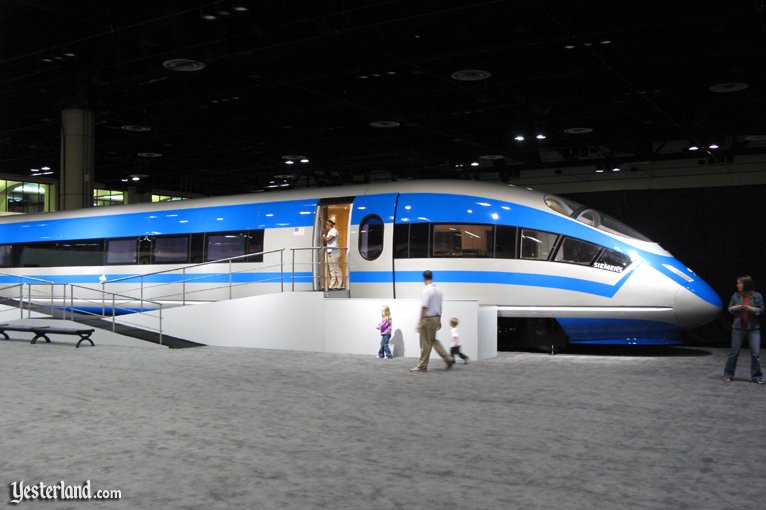
Mockup of a Velaro high-speed train by Siemens |
|||
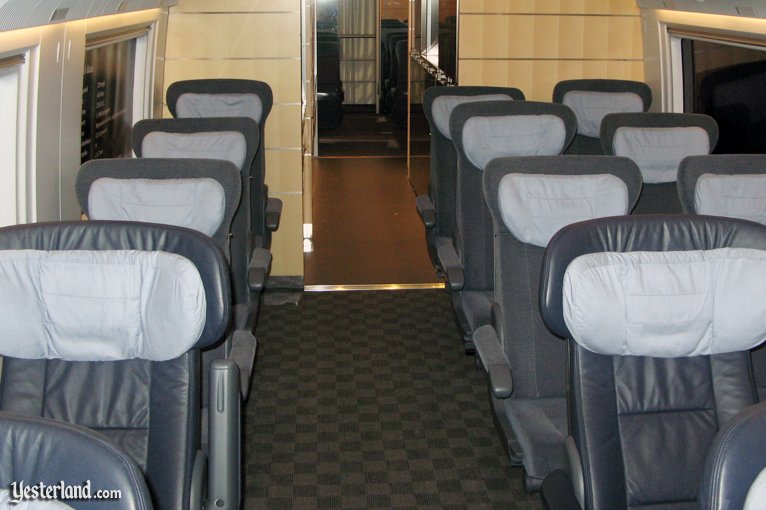
1 + 2 first class seating |
|||
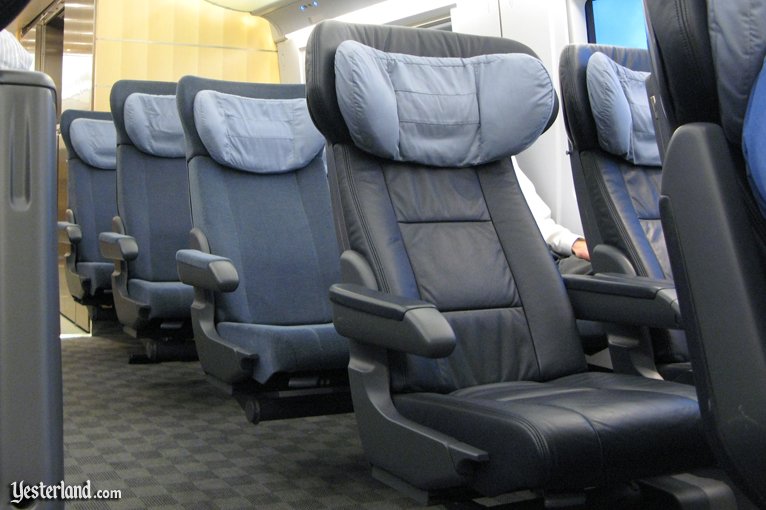
First class seats in leather or fabric |
|||
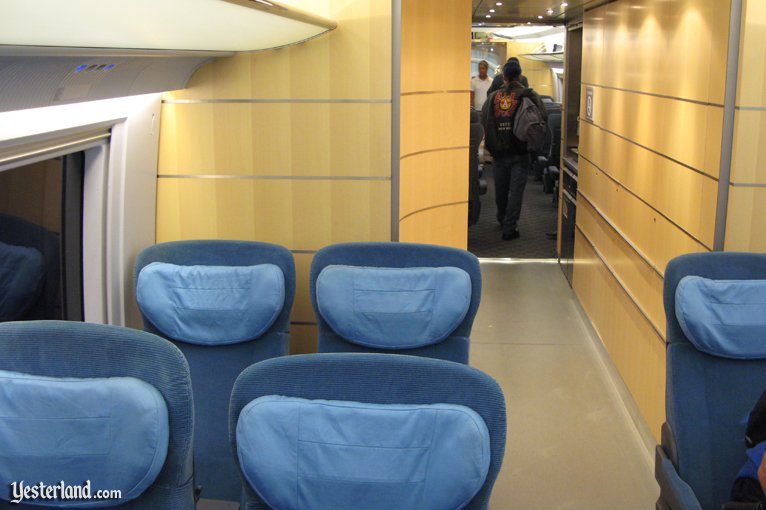
2 + 2 coach seating |
|||
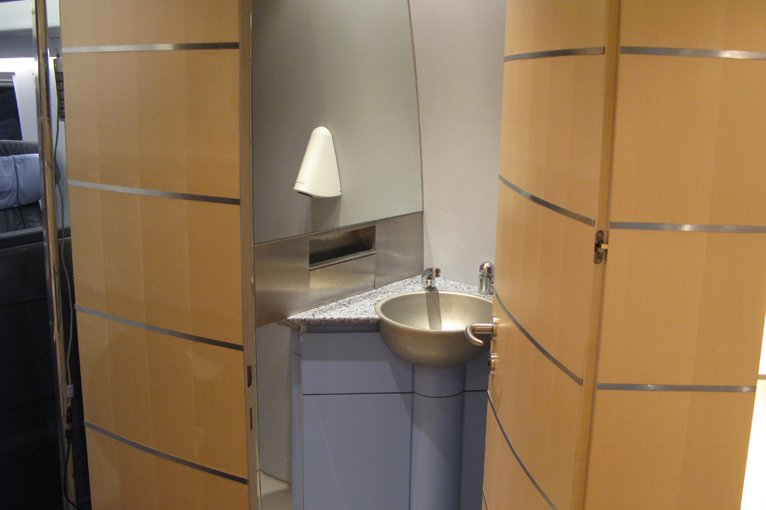
Even a stylish lavatory |
|||
|
Impressive train, eh? |
|||
© 2011 Werner Weiss — Disclaimers, Copyright, and Trademarks Updated March 18, 2011.
Photograph of nose of Siemens high speed train: 2010 by Werner Weiss. |
|||